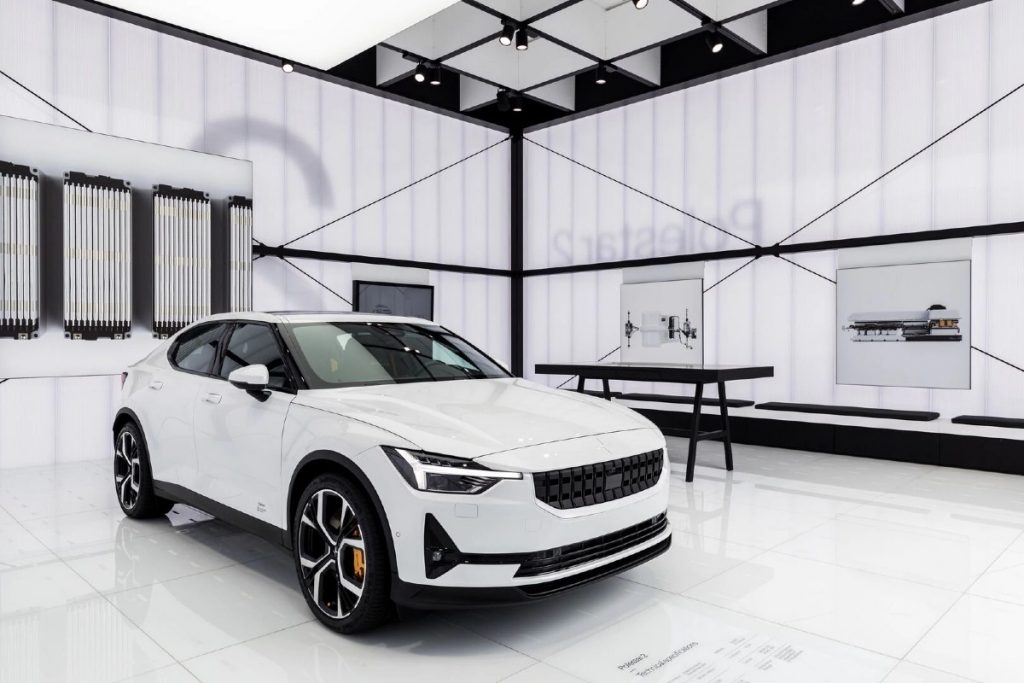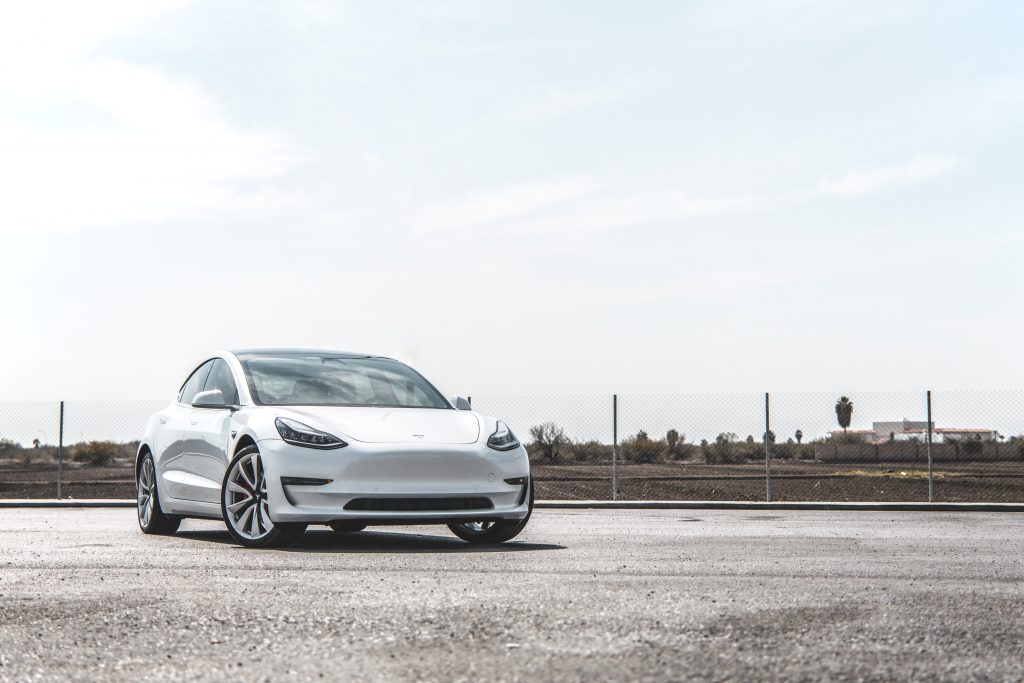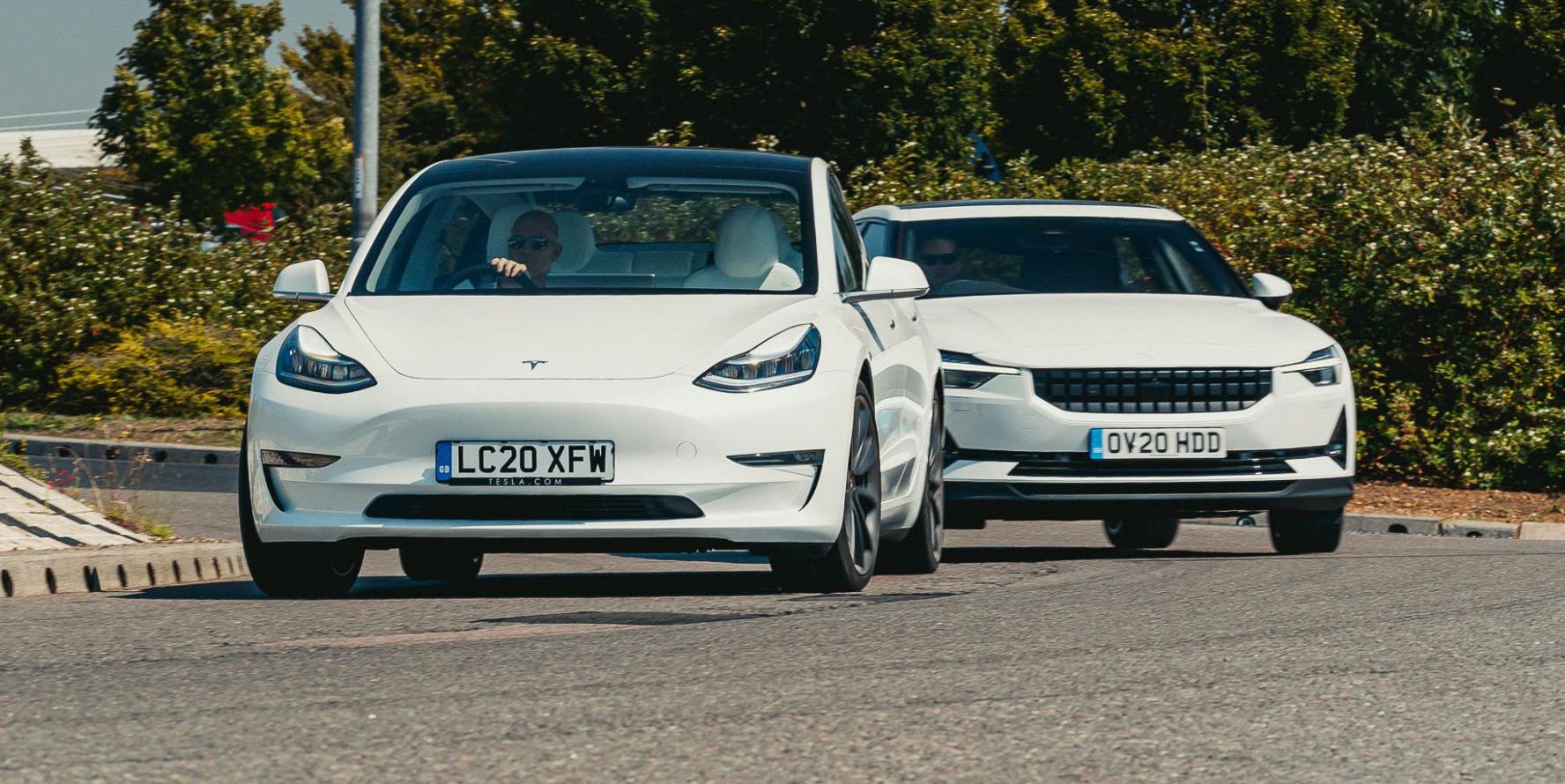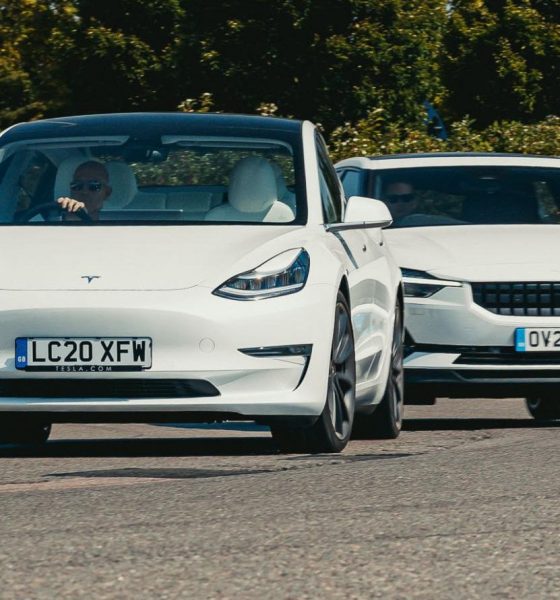The Tesla Model 3 and the Polestar 2 were recently pitted against each other by motoring outlet Top Gear. During the magazine’s review, the two vehicles were compared according to their efficiency, performance, and overall long trip capability, to name a new. As it turns out, it appears that the Polestar 2 is both the Model 3’s current biggest rival and strongest ally.
The Model 3 and the Polestar 2 are comparatively priced, with both vehicles commanding a price of about £600 per month in the UK. The two vehicles are also comparable when it comes to their batteries, with the Model 3 sporting a 75 kWh pack and the Polestar 2 being equipped with a 78 kWh unit. Consumption favors the Tesla during a 500-mile drive, however, as the Model 3 consumed 28.4 kW per 100 miles as opposed to the Polestar 2’s 35.7 kW per 100 miles. Part of this is due to the Polestar 2’s weight, which is about 595 lbs heavier than the Model 3.
That being said, when it comes to raw performance, the Model 3 proved to be far zippier than the Polestar 2, with the Tesla hitting 60 mph in 3.2 seconds and the Polestar 2 taking 4.4 seconds to hit highway speed. Top Gear then mentioned something quite interesting. During their test, they opted to put the Model 3 on Chill Mode for the most part while they were operating the vehicle. But even with Chill Mode, the Model 3 still made the Polestar 2 work hard to keep pace.

“This Tesla is the 450bhp Performance, and it pulled an easy ten lengths on the Polestar off every roundabout or away from each village, but we found ourselves driving it in power-reducing Chill mode most of the time, simply to escape the sudden, neck-straining step-off every time we gently pulled away. It’s very eager. Even in reverse, which is a bit disconcerting. Chill mode smoothed the throttle nicely and still made the Polestar work hard to keep pace,” the publication noted.
One thing that stands out is the fact that unlike the Model 3, which was built as an all-electric vehicle, the Polestar 2 is actually built on Volvo’s CMA architecture, which also underpins the popular XC40. The Polestar 2 is also made with steel panels, which are heavier than the aluminum that’s used in some parts of the Model 3. But despite this, the motoring publication noted that the Polestar, like the Tesla, does not feel heavy on the road at all, thanks to its low center of gravity.
Top Gear did state that there are some areas where the Model 3 falls beneath the Polestar 2. One of these is the vehicles’ interior quality, which is an area where Polestar excels in. Another concerns the two vehicles’ driving dynamics. The publication noted that the softer sprung Tesla gets a bit jiggled from side to side and it does not have impressive body control. The Model 3’s steering was also described as “pretty nasty,” as it has an initial resistance that fades as the driver turns.

The publication noted that the Model 3’s steering could not be described as “sporty or involving,” just effective. On the other hand, the Polestar 2’s steering and controls were described as reassuring in the way that they are “meatier and more satisfying.” But despite these drawbacks, the Model 3 still rides more comfortably compared to the Polestar 2.
The two vehicles also compare very well when it comes to their tech, as the Polestar 2’s Google-powered software experience stands pretty well against Tesla’s custom OS for the Model 3. Both vehicles have robust driver-assist features as well, though Top Gear noted that both Tesla and Volvo’s autonomous efforts still have large areas for improvement. This is especially true for Tesla, which sells a Full Self-Driving suite for the Model 3. Both cars are capable of long-distance travel, thanks to the Supercharger Network and Polestar’s partnership with Plugsurfing. But between the two, the Model 3 provides a faster, easier charging experience.
Ultimately, the Polestar 2 is a stellar effort on Volvo’s part. It’s attractive, well-built, and it carries the best of Volvo’s tech and features in an all-electric package. That being said, Top Gear concluded that ultimately, the Model 3 would likely still be the vehicle to choose if one were looking for an electric car, simply because it provides a more complete ecosystem of ownership.
“The Polestar experience is still very Volvo – and there’s nothing wrong with that. No Volvo drives as well as this, nor oozes more Scandi calmness and cool. It’s pure hygge. I know this is less than analytical but I love what it stands for, what it looks like, it’s the one I’d rather be seen driving and yet… the Tesla wins. Given a straight choice between the two, that’s the one I’d drive away. Nothing to do with its speed or autonomy – the two things usually championed by the Teslarati – but because of its ease of use, efficiency, the supercharger network. It’s the more complete mode of transport,” the magazine noted.

News
Tesla FSD fleet is nearing 7 billion total miles, including 2.5 billion city miles
As can be seen on Tesla’s official FSD webpage, vehicles equipped with the system have now navigated over 6.99 billion miles.

Tesla’s Full Self-Driving (Supervised) fleet is closing in on almost 7 billion total miles driven, as per data posted by the company on its official FSD webpage.
These figures hint at the massive scale of data fueling Tesla’s rapid FSD improvements, which have been quite notable as of late.
FSD mileage milestones
As can be seen on Tesla’s official FSD webpage, vehicles equipped with the system have now navigated over 6.99 billion miles. Tesla owner and avid FSD tester Whole Mars Catalog also shared a screenshot indicating that from the nearly 7 billion miles traveled by the FSD fleet, more than 2.5 billion miles were driven inside cities.
City miles are particularly valuable for complex urban scenarios like unprotected turns, pedestrian interactions, and traffic lights. This is also the difference-maker for FSD, as only complex solutions, such as Waymo’s self-driving taxis, operate similarly on inner-city streets. And even then, incidents such as the San Francisco blackouts have proven challenging for sensor-rich vehicles like Waymos.
Tesla’s data edge
Tesla has a number of advantages in the autonomous vehicle sector, one of which is the size of its fleet and the number of vehicles training FSD on real-world roads. Tesla’s nearly 7 billion FSD miles then allow the company to roll out updates that make its vehicles behave like they are being driven by experienced drivers, even if they are operating on their own.
So notable are Tesla’s improvements to FSD that NVIDIA Director of Robotics Jim Fan, after experiencing FSD v14, noted that the system is the first AI that passes what he described as a “Physical Turing Test.”
“Despite knowing exactly how robot learning works, I still find it magical watching the steering wheel turn by itself. First it feels surreal, next it becomes routine. Then, like the smartphone, taking it away actively hurts. This is how humanity gets rewired and glued to god-like technologies,” Fan wrote in a post on X.
News
Tesla starts showing how FSD will change lives in Europe
Local officials tested the system on narrow country roads and were impressed by FSD’s smooth, human-like driving, with some calling the service a game-changer for everyday life in areas that are far from urban centers.

Tesla has launched Europe’s first public shuttle service using Full Self-Driving (Supervised) in the rural Eifelkreis Bitburg-Prüm region of Germany, demonstrating how the technology can restore independence and mobility for people who struggle with limited transport options.
Local officials tested the system on narrow country roads and were impressed by FSD’s smooth, human-like driving, with some calling the service a game-changer for everyday life in areas that are far from urban centers.
Officials see real impact on rural residents
Arzfeld Mayor Johannes Kuhl and District Administrator Andreas Kruppert personally tested the Tesla shuttle service. This allowed them to see just how well FSD navigated winding lanes and rural roads confidently. Kruppert said, “Autonomous driving sounds like science fiction to many, but we simply see here that it works totally well in rural regions too.” Kuhl, for his part, also noted that FSD “feels like a very experienced driver.”
The pilot complements the area’s “Citizen Bus” program, which provides on-demand rides for elderly residents who can no longer drive themselves. Tesla Europe shared a video of a demonstration of the service, highlighting how FSD gives people their freedom back, even in places where public transport is not as prevalent.
What the Ministry for Economic Affairs and Transport says
Rhineland-Palatinate’s Minister Daniela Schmitt supported the project, praising the collaboration that made this “first of its kind in Europe” possible. As per the ministry, the rural rollout for the service shows FSD’s potential beyond major cities, and it delivers tangible benefits like grocery runs, doctor visits, and social connections for isolated residents.
“Reliable and flexible mobility is especially vital in rural areas. With the launch of a shuttle service using self-driving vehicles (FSD supervised) by Tesla in the Eifelkreis Bitburg-Prüm, an innovative pilot project is now getting underway that complements local community bus services. It is the first project of its kind in Europe.
“The result is a real gain for rural mobility: greater accessibility, more flexibility and tangible benefits for everyday life. A strong signal for innovation, cooperation and future-oriented mobility beyond urban centers,” the ministry wrote in a LinkedIn post.
News
Tesla China quietly posts Robotaxi-related job listing
Tesla China is currently seeking a Low Voltage Electrical Engineer to work on circuit board design for the company’s autonomous vehicles.

Tesla has posted a new job listing in Shanghai explicitly tied to its Robotaxi program, fueling speculation that the company is preparing to launch its dedicated autonomous ride-hailing service in China.
As noted in the listing, Tesla China is currently seeking a Low Voltage Electrical Engineer to work on circuit board design for the company’s autonomous vehicles.
Robotaxi-specific role
The listing, which was shared on social media platform X by industry watcher @tslaming, suggested that Tesla China is looking to fill the role urgently. The job listing itself specifically mentions that the person hired for the role will be working on the Low Voltage Hardware team, which would design the circuit boards that would serve as the nervous system of the Robotaxi.
Key tasks for the role, as indicated in the job listing, include collaboration with PCB layout, firmware, mechanical, program management, and validation teams, among other responsibilities. The role is based in Shanghai.
China Robotaxi launch
China represents a massive potential market for robotaxis, with its dense urban centers and supportive policies in select cities. Tesla has limited permission to roll out FSD in the country, though despite this, its vehicles have been hailed as among the best in the market when it comes to autonomous features. So far, at least, it appears that China supports Tesla’s FSD and Robotaxi rollout.
This was hinted at in November, when Tesla brought the Cybercab to the 8th China International Import Expo (CIIE) in Shanghai, marking the first time that the autonomous two-seater was brought to the Asia-Pacific region. The vehicle, despite not having a release date in China, received a significant amount of interest among the event’s attendees.










